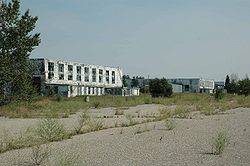
RCAF Station Claresholm
Encyclopedia

British Commonwealth Air Training Plan
The British Commonwealth Air Training Plan , known in some countries as the Empire Air Training Scheme , was a massive, joint military aircrew training program created by the United Kingdom, Canada, Australia and New Zealand, during the Second World War...
station that trained pilots for wartime
World War II
World War II, or the Second World War , was a global conflict lasting from 1939 to 1945, involving most of the world's nations—including all of the great powers—eventually forming two opposing military alliances: the Allies and the Axis...
service. The station was located near Claresholm
Claresholm, Alberta
Claresholm is a town located within southern Alberta, Canada. It is located on Highway 2, approximately northwest of the City of Lethbridge and south of the City of Calgary. The town is the seat of the Municipal District of Willow Creek No...
, Alberta
Alberta
Alberta is a province of Canada. It had an estimated population of 3.7 million in 2010 making it the most populous of Canada's three prairie provinces...
, Canada
Canada
Canada is a North American country consisting of ten provinces and three territories. Located in the northern part of the continent, it extends from the Atlantic Ocean in the east to the Pacific Ocean in the west, and northward into the Arctic Ocean...
. No. 15 Service Flying Training School (SFTS) was opened on June 9, 1941, and closed in March 1945. Anson
Avro Anson
The Avro Anson is a British twin-engine, multi-role aircraft that served with the Royal Air Force, Fleet Air Arm and numerous other air forces prior to, during, and after the Second World War. Named for British Admiral George Anson, it was originally designed for maritime reconnaissance, but was...
s and Cessna Cranes were the aircraft used. No. 2 Flying Instructor School (FIS) opened in April 1942 but closed September 1942 and moved to Vulcan
RCAF Station Vulcan
RCAF Station Vulcan, also referred to as RCAF Aerodrome Vulcan, was a Second World War flying training station located southwest of the town of Vulcan, Alberta, Canada. It was one station of many that were established in Canada under the British Commonwealth Air Training Plan.The Vulcan aerodrome...
. Student pilots at No.2 FIS flew Tiger Moths
De Havilland Tiger Moth
The de Havilland DH 82 Tiger Moth is a 1930s biplane designed by Geoffrey de Havilland and was operated by the Royal Air Force and others as a primary trainer. The Tiger Moth remained in service with the RAF until replaced by the de Havilland Chipmunk in 1952, when many of the surplus aircraft...
and Cessna Cranes
Cessna AT-17
-References:NotesBibliography* Mondey, David. American Aircraft of World War II . London: Bounty Books, 2006. ISBN 978-0-7537-1461-4....
.
Claresholm was placed on care and maintenance status until reactivated in 1951 as a NATO training centre run by No. 3 Flying Training School (flying Harvards). The station closed again in 1958 when the school was relocated to Gimli
RCAF Station Gimli
RCAF Station Gimli was an air station of the Royal Canadian Air Force located near Gimli, Manitoba, Canada.On September 6, 1943, the British Commonwealth Air Training Plan established No. 18 Service Flying Training School to train aircrew for Second World War operations using the Avro Anson. No...
, Manitoba
Manitoba
Manitoba is a Canadian prairie province with an area of . The province has over 110,000 lakes and has a largely continental climate because of its flat topography. Agriculture, mostly concentrated in the fertile southern and western parts of the province, is vital to the province's economy; other...
. It is now the Claresholm Industrial Airport
Claresholm Industrial Airport
Claresholm Industrial Airport is located south southwest of Claresholm, Alberta, Canada.The airport opened in 1941 as RCAF Station Claresholm as part of the British Commonwealth Air Training Plan and closed in 1945. In 1951 it was reopened as a NATO training centre and closed again in 1958 when...
. As of August, 2011 hangers 2 to 4 are derelict and deteriorating.

